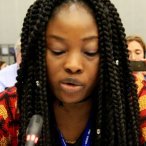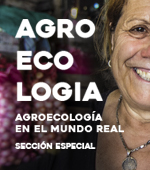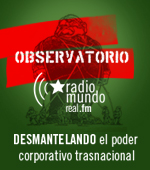English · Español

14 de diciembre de 2016 | Noticias | Anti-neoliberalismo | Bosques y biodiversidad | COP de Diversidad Biológica
FOEI and Allied NGOs Call for More Regulation on Synthetic Biology at the COP 13
By Marie-Pia Rieublanc, member of Otros Mundos Chiapas – Friends of the Earth Mexico.
Descargar: MP3 (4.1 MB)
Mariann Bassey Orovwuje, member of Environmental Rights Action - Friends of the Earth Nigeria, was part of the Friends of the Earth International delegation that participated in the thirteenth Conference of the Parties (COP 13) to the UN Convention on Biological Diversity (CBD) held in Cancun, Mexico.
Bassey made a statement on behalf of the Civil Society Working Group on Synthetic Biology during a plenary session that took place on December 6th, calling for more regulation on synthetic biology.
Before the Parties and the rest of the NGOs participating as observers in the COP 13, the activist warned that “gene drives have quickly emerged as an extremely high risk synthetic biology application since the last COP” and therefore “should be placed under a moratorium”.
This request has also been made by 168 organizations worldwide, including Friends of the Earth International, who signed a “Common call for a global moratorium on gene drives”. The signatories want a moratorium on any further technical development and experimental application of gene drives and on their environmental release.
VIDEO - Mariann Bassey Orovwuje’s statement at the COP 13:
https://www.youtube.com/watch?v=7k9DEgWqrjs
Gene drives can alter ecosystems and boost agrochemical sales
Gene drives are an experimental genetic engineering technology which is raising a lot of concerns within the civil society. It consists of passing on a specific bioengineered trait to all or most of the offsprings of a species so that this trait becomes dominant in wild populations of the target species over a few generations. This technology can be used to eradicate invasive animal species for conservative purposes, weed species for agricultural purposes or insects like the mosquitoes that transmit malaria for health security purposes.
The problem is that given the current state of science, it is not possible to predict the ecological impacts of the environmental release of gene drives. Eradicating a single species or modifying its behavior can alter ecosystems. Suppressing a weed species can lead, for example, to the loss of habitat for animal species and the establishment of invasive ones.
Gene drives are developed using a gene editing system called CRISPR-Cas9. In agriculture, its development can boost agrochemical sales because there have been proposals to render weed species susceptible to proprietary agrochemicals (just like Monsanto rendered its GMOs resistant to Roundup herbicide).
[All the information about gene drives in this article has been extracted from the document “The Case for a Global Moratorium on Genetically-engineered Gene Drives”published by the Civil Society Working Group on Gene Drives, in which FOEI is also participating.]
Synthetic Biology needs an operational definition
Bassey called on the Parties to “adopt an operational definition of synthetic biology”, as the lack of a definition is already hindering work on this topic under the CBD and its Protocols (the Nagoya and then Cartagena Protocols) and has been used as an argument against assessing the risk of synthetic biology.
According to the Civil Society Working Group on Synthetic Biology, which comprises other organizations such as EcoNexus, Ecoropa, ETC Group, Heinrich Böll Foundation, The Sustainability Council and Third World Network, synthetic biology is “the next generation of biotechnologies that attempt to engineer, redesign, re-edit and synthesize biological systems, including at the genetic level”. The definition to be adopted by the CBD and the Protocols “should include techniques for genome editing and genome synthesis”, said the Group in its document “Synthetic Biology and the CBD”.
Digital sequencing can lead to digital biopiracy if not regulated
The Nigerian activist pointed out the need to address the “urgent issue” of digital sequences and biopiracy within the CBD and the Nagoya Protocol. “Rapid advances in sequencing and synthesizing DNA mean that digital biopiracy is now possible, circumventing the rules on access and benefit sharing (ABS)” set up by the Nagoya Protocol, warned the Civil Society Working Group on Synthetic Biology in its document “Synthetic Biology and the CBD”. By ABS, the Nagoya Protocol means the sharing of the benefits arising from the use of genetic resources and states that it must be done in a fair and equitable way.
The risk with genetic resources (DNA sequencing, for example) is that they can be transferred digitally and synthesized into living matter without physical exchange of biological material, “which poses major challenges to the many ABS systems that assume and utilize material transfer agreements”, wrote the Group. “It is important for the CBD to take a leading role in determining how to ensure that digital sequence information and gene editing are not used to amplify biopiracy and undermine ABS regimes.”
A need to address the Socio-Economic and Ecological impacts of Synthetic Biology
“The Convention requires an ongoing process to address the impacts of synthetic biology on sustainable use of biodiversity — especially the socioeconomic and indirect impacts”, said Bassey during the plenary. For example, some natural products are being produced with synthetic biology techniques by the synthetic biology industry instead of farmers, and more synthetic biology products are being developed — there is a huge risk that farmers lose their livelihoods.
Bassey also called on the Parties to address the issue of synthetic biology under the focus of biosafety as part of the Cartagena Protocol. She said they should come up with a process for developing guidelines based on the “Risk Assessment under the Cartagena Protocol” draft written by the AHTEG. This is a pressing issue given that synthetic biology is likely to lead to the development of organisms that will differ fundamentally from naturally occurring ones.
[All the information about synthetic biology in this article has been extracted from the document “Synthetic Biology and the CBD”, published by the Civil Society Working Group on Synthetic Biology.]
For Civil Society online resources on Synthetic Biology, visit Synbiowatch
Imagen: Marie-Pia Rieublanc.








